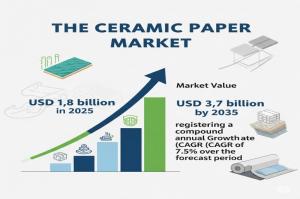Ceramic Paper Market to Reach USD 3.7 Billion by 2035, Driven by Fire Safety Codes & EV Battery Insulation Demand | FMI
UK ceramic paper market grows at 7.1% CAGR, driven by fire-safe insulation demand, EV batteries, retrofits, and sustainable fiber-forming technologies.
NEWARK, DE, UNITED STATES, August 18, 2025 /EINPresswire.com/ -- The global ceramic paper market is entering a transformative growth phase, with market value projected to rise from USD 1.8 billion in 2025 to USD 3.7 billion by 2035, advancing at a 7.5% CAGR. As industries worldwide face escalating demands for energy efficiency, safety compliance, and lightweight materials, ceramic paper has emerged as a critical solution engineered to withstand extreme operating conditions while meeting the next generation of manufacturing standards.
Industrial Performance Driving Market Expansion
By 2025, industrial insulation applications are expected to command 42.9% of the total market share, reinforcing ceramic paper’s role as the cornerstone of high-temperature operations. Used extensively in kilns, furnaces, boilers, and reactors, ceramic paper delivers excellent thermal resistance, flexibility, and low thermal conductivity.
With global industries striving to minimize energy loss and enhance operational safety, ceramic paper is increasingly integrated into furnace linings, duct insulation, and flame protection systems. The material’s low outgassing properties and chemical inertness make it indispensable in sectors where stringent environmental regulations and sustainability goals are reshaping production processes. Manufacturers adopting ceramic paper benefit from reduced maintenance cycles, longer equipment life, and lower operating costs.
Aerospace, Automotive, and Fire Safety Sectors Expanding Usage
The combined aerospace and automotive industries are forecasted to account for 20–25% of market demand by 2025. Here, ceramic paper’s lightweight heat-shielding properties allow manufacturers to improve thermal management without compromising efficiency. In electric vehicles, ceramic paper is being integrated into battery insulation systems, while aerospace applications deploy it in engine linings, exhaust systems, and thermal barriers to withstand extreme operating conditions.
Fire safety remains another crucial driver, contributing 10–15% of global market demand. As governments impose stricter fire protection codes, ceramic paper is increasingly specified in fire wraps, expansion joints, and protective barriers. Its non-combustible, high-temperature stability makes it a reliable choice for infrastructure projects, public facilities, and transportation systems where safety is paramount.
Advanced Ceramic Paper: The Market Leader
Advanced ceramic paper is expected to represent 53.6% of total revenue in 2025, cementing its leadership due to superior performance under extreme thermal and chemical stress. Withstanding temperatures beyond 1200°C, advanced ceramic paper is increasingly used in expansion joints, gaskets, pipe wrapping, and vacuum environments where purity and dimensional stability are critical.
The absence of organic binders enhances thermal efficiency, while customizable thickness and density allow adaptation across specialized applications—from aerospace components to semiconductor systems. As industries demand high-specification, low-mass insulation materials, advanced ceramic paper is solidifying its position as the material of choice for critical operations.
Roll Format Driving Operational Efficiency
Among formats, ceramic paper rolls are anticipated to capture 45.1% of market share by 2025. Rolls offer seamless coverage, minimal thermal leakage, and faster installation across large industrial surfaces. Their consistent thickness and fiber distribution deliver reliability in metal treatment, ceramics, chemical processing, and high-volume furnace applications.
Manufacturers benefit from the roll format’s compatibility with automated lamination systems, streamlined shipping, and flexible deployment, ensuring both cost savings and operational efficiency.
Regional Outlook: China and India Lead Global Growth
From 2025 to 2035, China is projected to dominate with a 10.1% CAGR, fueled by rapid expansion in steel, aluminum, and power generation sectors. Government-led initiatives for energy efficiency and industrial safety, combined with large-scale EV battery insulation projects, are accelerating adoption.
India follows with a 9.4% CAGR, driven by growth in cement, steel, and foundry industries. Domestic manufacturers, supported by global collaborations, are scaling production to meet rising demand in renewable energy, EV batteries, and sustainable construction projects.
In Europe, Germany (8.6% CAGR) and France (7.9% CAGR) lead growth with applications in automotive, aerospace, clean energy, and hydrogen projects, while the United Kingdom (7.1% CAGR) drives adoption through fire-safe building retrofits and EV battery insulation.
Key Market Drivers and Industry Challenges
The growth trajectory of ceramic paper is underpinned by three core drivers:
1. High-Temperature Insulation Needs – Ceramic paper withstands temperatures exceeding 1000°C, making it indispensable for metallurgical, petrochemical, and glass manufacturing.
2. Regulatory Compliance – Asbestos-free, non-combustible insulation solutions are now mandated across many regions, positioning ceramic paper as a compliant alternative.
3. Energy Efficiency and Lightweighting – With industries prioritizing reduced thermal loss and lighter material footprints, ceramic paper aligns with evolving design priorities.
However, challenges remain. Quality consistency is a pressing concern for manufacturers, as maintaining uniform thickness, density, and fiber orientation is essential for large-scale adoption in aerospace, energy, and automotive OEM applications.
Inconsistencies can lead to installation errors, warranty claims, and reduced reliability. Overcoming these production hurdles through automation, inline quality control, and improved fiber processing remains critical to industry confidence.
Request Ceramic Paper Market Draft Report:
https://www.futuremarketinsights.com/reports/sample/rep-gb-22986
For more on their methodology and market coverage, visit https://www.futuremarketinsights.com/about-us.
Competitive Landscape
The ceramic paper market reflects a tiered competitive structure:
• Tier 1 players like Morgan Thermal Ceramics, Unifrax, and Shadong Luyang Share Co., Ltd. dominate with global R&D investment, specialized product variants, and strong OEM partnerships.
• Tier 2 suppliers focus on cost-performance solutions for refractory construction, fire protection, and glass processing.
• Tier 3 manufacturers, often regional players, address niche and small-scale needs, offering flexible production runs and competitively priced solutions.
This layered market ensures both global and local manufacturers can find opportunities from serving heavy industry insulation projects to catering to specialized laboratory and maintenance needs.
Related Insights from Future Market Insights (FMI)
Ceramic Balls Market - https://www.futuremarketinsights.com/reports/ceramic-balls-market
Ceramic Membranes Market - https://www.futuremarketinsights.com/reports/ceramic-membranes-market
Ceramic Tester Market - https://www.futuremarketinsights.com/reports/ceramic-tester-market
Ceramic Barbeque Grill Market - https://www.futuremarketinsights.com/reports/kamado-grill-market
Editor’s Note:
The Ceramic Paper Market is entering a transformative phase, driven by rising demand for high-temperature insulation and energy efficiency. With applications spanning industrial furnaces, aerospace, and automotive, manufacturers are leveraging ceramic paper’s lightweight, durable, and heat-resistant properties. This report highlights market growth, opportunities, and innovations shaping the industry’s future.
Rahul Singh
Future Market Insights Inc.
+1 347-918-3531
email us here
Legal Disclaimer:
EIN Presswire provides this news content "as is" without warranty of any kind. We do not accept any responsibility or liability for the accuracy, content, images, videos, licenses, completeness, legality, or reliability of the information contained in this article. If you have any complaints or copyright issues related to this article, kindly contact the author above.
Car Lube Container Market to Hit USD 8.4 billion by 2035, Driving Solutions for Auto Packaging
Oil Mill Machine Market Forecast Outlook 2025 to 2035 Driven by Automation, Efficiency, and Growing Edible Oil Demand
Microcontroller Market Growth Accelerates as Demand Surges Across Key Industries
Więcej ważnych informacji
 Jedynka Newserii
Jedynka Newserii

 Jedynka Newserii
Jedynka Newserii

Konsument

Wzrost sprzedaży piw bezalkoholowych idzie w parze z inwestycjami w zieloną energię. Kompania Piwowarska ogranicza ślad węglowy i wspiera lokalne inicjatywy
Kompania Piwowarska kontynuuję realizację strategii „Lepsza Przyszłość 2030”, w której łączy ambitne cele środowiskowe, edukacja konsumentów oraz rozwój segmentu piw bezalkoholowych z realnym wsparciem dla lokalnych społeczności. Firma, będąca liderem polskiego rynku piwa, ogranicza emisję CO₂, zwiększa udział opakowań zwrotnych i angażuje pracowników w wolontariat, w tym m.in. w pomoc dla ofiar powodzi na Dolnym Śląsku.
Handel
D. Joński: Europa musi chronić swój rynek poprzez cła i wysokie standardy bezpieczeństwa dla importowanych towarów. Powinniśmy budować własny przemysł oparty na tańszej energii

Tańsza energia, a przez to niższe koszty produkcji w Europie to jeden z kierunków, który wskazuje Unia Europejska w rywalizacji z tanimi towarami z Azji, głównie z Chin. Jednocześnie rynek Starego Kontynentu powinien być chroniony poprzez zbalansowane cła oraz wysokie standardy bezpieczeństwa stawiane importowanym produktom. Zdaniem europosła Dariusza Jońskiego ważne jest rozwijanie przemysłu w Europie bez względu na narodowość właścicieli. Relacje z Chinami muszą zostać na nowo zdefiniowane i przebiegać na równych zasadach.
Handel
Poprawia się jakość raportów dużych spółek giełdowych dotyczących zrównoważonego rozwoju. Pozostają też obszary do dopracowania

Ekspertki i eksperci z Deloitte’a przeprowadzili analizę ujawnień taksonomicznych spółek notowanych na Giełdzie Papierów Wartościowych, która objęła sprawozdania z działalności za rok 2024 w części dotyczącej zrównoważonego rozwoju. To trzeci rok ujawniania stopnia zgodności przedsiębiorstw z Taksonomią Unii Europejskiej, co przekłada się na zwiększoną jakość i porównywalność prezentowanych danych. Jednocześnie można oczekiwać, że inwestycje zgodne z Taksonomią będą coraz istotniejszym elementem strategii rozwoju przedsiębiorstw w kolejnych latach.
Partner serwisu
Szkolenia

Akademia Newserii
Akademia Newserii to projekt, w ramach którego najlepsi polscy dziennikarze biznesowi, giełdowi oraz lifestylowi, a także szkoleniowcy z wieloletnim doświadczeniem dzielą się swoją wiedzą nt. pracy z mediami.









.gif)

 |
| |
| |
|